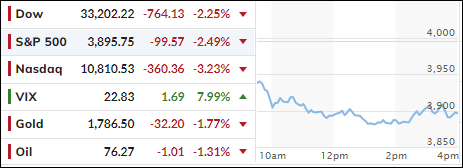
- Moving the markets
Even though the Fed hiked rates as expected, a “morning after” hangover set in, as today’s poor retail sales confirmed current recessionary tendencies. Sales dropped -0.6% in November, which was twice the expectations of a -0.3% decline.
US Industrial Production did not help matters, because it fell 0.2% MoM (0% expected) and dropped to its weakest since September 2021, according to ZeroHedge.
Regarding the Fed’s stance on interest rates, analyst Peter Schiff summarized it best:
Now, that doesn’t mean the Fed shouldn’t be raising rates. They should be. They should have raised them a lot more than they have. The problem is they never should have cut them. That was the mistake — it was cutting rates. Raising them back up is really just an acknowledgment of that mistake. But what happens is when the Fed raises rates, it uncovers all of the problems that it created when it reduced rates. Because when it slashed interest rates to zero, it inflated a bubble economy, and it inflated it with inflation. Quantitative easing was inflation.
Then we learned that the Philadelphia Fed admitted that US Jobs were “overstated” by at least 1.1 million, a shocking story that you may want to read in detail, if this topic interests you.
As a result, the major indexes were spanked and yet again, there was no place to hide. Our Trend Tracking Indexes (TTIs) were slammed as well but remained a tad above their respective trend lines.
We’re now facing the possibility that our recent “Buy” signal may turn out to have been a head fake, but it’s too early to tell. Tomorrow’s $4 trillion options expirations session may shed more light on where the major trend is headed into the end of the year.
2. “Buy” Cycle Suggestions
For the current Buy cycle, which starts on 12/1/2022, I suggest you reference my most recent StatSheet for ETFs selections. If you come on board later, you may want to look at the most current version, which is published and posted every Thursday at 6:30 pm PST.
I also recommend for you to consider your risk tolerance when making your selections by dropping down more towards the middle of the M-Index rankings, should you tend to be more risk adverse. Likewise, a partial initial exposure to the markets, say 33% to start with, will reduce your risk in case of a sudden directional turnaround.
We are living in times of great uncertainty, with economic fundamentals steadily deteriorating, which will eventually affect earnings negatively and, by association, stock prices. I can see this current Buy signal to be short lived, say to the end of the year, and would not be surprised if it ends at some point in January.
In my advisor practice, we are therefore looking for limited exposure in value, some growth and dividend ETFs. Of course, gold has been a core holding for a long time.
With all investments, I recommend the use of a trailing sell stop in the range of 8-12% to limit your downside risk.
3. Trend Tracking Indexes (TTIs)
Our TTIs dumped but are still staying in bullish territory.
This is how we closed 12/15/2022:
Domestic TTI: +0.27% above its M/A (prior close +2.52%%)—Buy signal effective 12/1/2022.
International TTI: +0.77% above its M/A (prior close +3.31%)—Buy signal effective
12/1/2022.
Disclosure: I am obliged to inform you that I, as well as my advisory clients, own some of the ETFs listed in the above table. Furthermore, they do not represent a specific investment recommendation for you, they merely show which ETFs from the universe I track are falling within the specified guidelines.
All linked charts above are courtesy of Bloomberg via ZeroHedge.
Contact Ulli